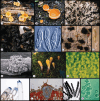The Fungal Tree of Life: from Molecular Systematics to Genome-Scale Phylogenies
- PMID: 28917057
- PMCID: PMC11687545
- DOI: 10.1128/microbiolspec.FUNK-0053-2016
The Fungal Tree of Life: from Molecular Systematics to Genome-Scale Phylogenies
Abstract
The kingdom Fungi is one of the more diverse clades of eukaryotes in terrestrial ecosystems, where they provide numerous ecological services ranging from decomposition of organic matter and nutrient cycling to beneficial and antagonistic associations with plants and animals. The evolutionary relationships of the kingdom have represented some of the more recalcitrant problems in systematics and phylogenetics. The advent of molecular phylogenetics, and more recently phylogenomics, has greatly advanced our understanding of the patterns and processes associated with fungal evolution, however. In this article, we review the major phyla, subphyla, and classes of the kingdom Fungi and provide brief summaries of ecologies, morphologies, and exemplar taxa. We also provide examples of how molecular phylogenetics and evolutionary genomics have advanced our understanding of fungal evolution within each of the phyla and some of the major classes. In the current classification we recognize 8 phyla, 12 subphyla, and 46 classes within the kingdom. The ancestor of fungi is inferred to be zoosporic, and zoosporic fungi comprise three lineages that are paraphyletic to the remainder of fungi. Fungi historically classified as zygomycetes do not form a monophyletic group and are paraphyletic to Ascomycota and Basidiomycota. Ascomycota and Basidiomycota are each monophyletic and collectively form the subkingdom Dikarya.
Figures





References
-
- Grigoriev IV, Cullen D, Goodwin SB, Hibbett D, Jeffries TW, Kubicek CP, Kuske C, Magnuson JK, Martin F, Spatafora JW, Tsang A, Baker SE. 2011. Fueling the future with fungal genomics. Mycology 2:192–209. [PubMed]
-
- Boeckmann B, Marcet-Houben M, Rees JA, Forslund K, Huerta-Cepas J, Muffato M, Yilmaz P, Xenarios I, Bork P, Lewis SE, Gabaldón T, Quest for Orthologs Species Tree Working Group. 2015. Quest for orthologs entails quest for tree of life: in search of the gene stream. Genome Biol Evol 7:1988–1999 10.1093/gbe/evv121. [PubMed] - DOI - PMC - PubMed
Publication types
MeSH terms
LinkOut - more resources
Full Text Sources
Other Literature Sources
Medical

